Research Discussion Paper – RDP 2020-06 Consumer Payment Behaviour in Australia: Evidence from the 2019 Consumer Payments Survey
1. Introduction
The Reserve Bank conducted its fifth triennial Consumer Payments Survey (CPS) in October and November 2019.[1] The CPS provides comprehensive data on how Australian consumers make their payments as well as qualitative information on payment preferences and attitudes. It is one of the main sources of information on the use of cash – for transactions and other purposes – in the Australian economy. Just over 1,100 people participated in the 2019 CPS, recording details of every transaction they made for a week as well as providing additional information in a post-survey questionnaire. As in previous survey waves, participants were recruited so that the sample was representative of the Australian population.
The way in which Australians are making payments is changing. New payment methods are emerging, often enabled by mobile technology, while transactional use of cash is declining. Accordingly, the 2019 CPS asked participants to report more information than in previous surveys on their use of newer electronic payment methods and channels, as well as in-depth information on their use of and attitudes towards cash. The CPS was conducted before the emergence of COVID-19 in Australia, which has induced substantial changes in payment behaviour. Accordingly, it provides a valuable snapshot of consumers' payment patterns and preferences immediately prior to the pandemic.
This paper discusses the results of the 2019 CPS in the context of a changing retail payments system. It focuses on consumers' use of cash, payment cards and non-traditional ‘alternative’ payment methods, as well as insights into people's payment attitudes and preferences.[2]
2. Survey Overview
The CPS is a national cross-sectional survey that has been conducted every three years since 2007. The 2019 CPS comprised three sections: a pre-diary questionnaire about the demographic characteristics of respondents; a payments diary; and a post-survey questionnaire focusing on respondents' payment preferences and attitudes. In the diary, respondents recorded details about each transaction and cash withdrawal that they initiated over a seven-day period (automatic payments over the week were recorded in the post-diary survey). For each transaction, respondents reported the value, payment method, payment channel (e.g. if they tapped or inserted their card, made a payment using an app) and the type of merchant. For each cash withdrawal, respondents reported the value and source of the top-up (e.g. an ATM); they also reported their banknote holdings at the start and end of the diary period. Respondents were asked to include only personal transactions in their diary, not those made for business reasons.
The survey was delivered online for most respondents but to ensure the sample was broadly representative of the Australian population, participants without internet access were recruited by telephone to complete a paper-based survey. Participants were recruited to the survey to ensure that the sample was consistent with Australian Bureau of Statistics and the Household, Income and Labour Dynamics in Australia (HILDA) Survey population benchmarks for age, sex, household income, state of residence, credit card ownership and internet access (where necessary, the Reserve Bank weighted responses to align the sample with these benchmarks; see Appendix A for more information). A total of 1,115 people participated in the 2019 CPS, recording around 13,500 payments, 800 cash withdrawals and 1,500 automatic payments in their seven-day diary periods. For further details on the survey, see Appendix A.
3. Key Trends in Consumer Payments
The 2019 CPS showed that Australians are continuing to switch to electronic payment methods in preference to cash for their day-to-day transactions. Debit cards were the most frequently used means of payment in 2019, overtaking cash as the single most commonly used payment method for the first time.[3] Overall, payment cards – debit and credit cards combined – were used for 63 per cent of the number of consumer payments in 2019, compared with 52 per cent three years earlier (Table 1). More recently, the switch to electronic payment methods is likely to have accelerated as a result of consumer and merchant responses to COVID-19.[4]
One of the most notable developments in recent surveys has been the strong growth in contactless card payments as a result of widespread adoption of this functionality by consumers and merchants. The share of in-person payments made by tapping a debit or credit card on a card terminal increased to 50 per cent in 2019, from 10 per cent in 2013. Consumers are using cards more frequently for payments of all sizes and the adoption of contactless functionality has facilitated particularly strong growth in the use of cards for low-value transactions in recent years. For example, the share of in-person payments of $10 or less that were made with cards rose by 20 percentage points relative to three years earlier, to 51 per cent in 2019. The 2019 CPS also showed that Australian consumers used mobile phones or other payment-enabled devices to make ‘tap and go’ payments more often than they did three years ago, although such mobile payments still accounted for a relatively small share (around 5 per cent) of in-person payments. Other means of electronic payment such as BPAY and internet banking applications account for relatively small shares of the number of consumer payments (but a higher share when measured by the value of transactions).
| 2007 | 2010 | 2013 | 2016 | 2019 | |
|---|---|---|---|---|---|
| Number of payments | |||||
| Cash | 69 | 62 | 47 | 37 | 27 |
| Cards | 26 | 31 | 43 | 52 | 63 |
| Debit cards | 15 | 22 | 24 | 30 | 44 |
| Credit and charge cards | 11 | 9 | 19 | 22 | 19 |
| BPAY | 2 | 3 | 3 | 2 | 2 |
| Internet/phone banking(a) | na | 2 | 2 | 1 | 3 |
| PayPal | na | 1 | 3 | 3 | 2 |
| Cheque | 1 | 1 | 0.4 | 0.2 | 0.2 |
| Other(b) | 1 | 1 | 2 | 4 | 2 |
| Value of payments | |||||
| Cash | 38 | 29 | 18 | 18 | 11 |
| Cards | 43 | 43 | 53 | 54 | 61 |
| Debit cards | 21 | 27 | 22 | 26 | 36 |
| Credit and charge cards | 23 | 16 | 31 | 28 | 25 |
| BPAY | 10 | 10 | 11 | 8 | 9 |
| Internet/phone banking(a) | na | 12 | 10 | 10 | 14 |
| PayPal | na | 1 | 2 | 4 | 2 |
| Cheque | 6 | 3 | 2 | 2 | 2 |
| Other(b) | 3 | 3 | 5 | 3 | 2 |
|
Notes: Excludes payments over $9,999, transfers (payments to family and friends), transport cards and automatic payments Source: RBA calculations, based on data from Colmar Brunton, Ipsos and Roy Morgan Research |
|||||
With Australian consumers increasingly preferring to make their payments electronically, the trend decline in transactional use of cash continued. Cash was used for 27 per cent of consumer payments (by number) in 2019, whereas almost 70 per cent of payments were made in cash in 2007. While the decline in the relative use of cash has been widespread throughout the economy, cash was still used for a material share of certain transactions (e.g. at businesses such as cafes that have predominantly low-value payments). Consumers in all broad demographic groups are using cash less frequently than they used to, though the shift to electronic payments has not been as pronounced among older Australians and lower-income groups (Figure 1).

Note: Because of the overlap between age and income groups, the figures for income quartiles are adjusted for respondents' age
Source: RBA calculations, based on data from Roy Morgan Research
Similar trends in consumer payments have been apparent in a number of other economies. Data from broadly similar surveys conducted in a number of other advanced economies show that consumers globally are shifting away from cash to cards, although there are also some notable differences across economies (Figure 2).[5] Sweden and Norway are prominent examples of jurisdictions where cash is used for a relatively small proportion of consumer payments, whereas cash is more commonly used in some euro area countries.[6] China is another example of a country in which there has been a marked increase in the relative use of electronic payment methods, facilitated by the widespread adoption of digital wallet services.

Notes: Cash and card do not sum to 100; observations are not directly comparable due to differing survey methods and inclusions across economies
Sources: Bank of Canada; Colmar Brunton; De Nederlandsche Bank; Deutsche Bundesbank; European Central Bank; Federal Reserve Bank of San Francisco; Ipsos; Norges Bank; RBA; Roy Morgan Research; Sveriges Riksbank
4. Cash
4.1 Cash Payments
The share of consumer payments made using cash has continued to fall, with cash accounting for 27 per cent of the number of consumer payments in 2019, compared to 37 per cent in 2016 (Figure 3). When measured by the value of consumer payments (rather than the number), the share of cash payments fell to 11 per cent, after being fairly stable at a little under 20 per cent in the previous two surveys. The decline in the relative use of cash in recent years largely reflects more frequent use of cards for in-person payments (as discussed below), though over a longer horizon it is also consistent with a higher share of payments being made online than they were a decade or so ago.

Note: Excludes payments over $9,999, transfers (payments to family and friends), transport cards and automatic payments
Source: RBA calculations, based on data from Colmar Brunton, Ipsos and Roy Morgan Research
Whereas cash has historically been the preferred option for lower-value payments, consumers are increasingly switching to cards for these transactions. For example:
- Cards overtook cash as the most common way of making payments of $10 or less for the first time in the 2019 CPS. Cash accounted for 45 per cent of these payments in 2019, compared to 62 per cent in 2016.
- The payment value at which cash is the most common means of payment has been falling over time. In 2019, this ‘threshold’ was just $4, whereas cash was the most frequently used payment method for payments up to $12 in 2016, and up to $41 in 2007 (Figure 4).
The shift away from cash for smaller transaction sizes reflects both changing consumer preferences and widespread merchant acceptance of electronic payment methods – particularly contactless cards – for even small payments (see below).[7] Among other things, this has led to a transition away from cash in sectors where cash has traditionally been used for a high share of transactions, such as smaller (non-supermarket) food retailers including cafés, pubs and takeaway food outlets (Figure 5). These businesses had a median transaction size of $12 in 2019, and the share of cash payments declined by nearly 20 percentage points relative to three years earlier.

Note: $5-centred moving average; for example, the $6 share is an average of the payment method share at $4, $5, $6, $7 and $8
Source: RBA calculations, based on data from Roy Morgan Research

Source: RBA calculations, based on data from Ipsos and Roy Morgan Research
The ongoing decline in cash use was also evident across different demographic groups, with consumers of all ages, income groups and regions using cash less frequently than they did previously. There was a particularly pronounced shift away from cash for younger respondents: consumers aged under 40 made just under 15 per cent of their weekly payments in cash in 2019, compared with around 30 per cent three years earlier (and around 65 per cent in 2007) (Table 2). In contrast, cash was still the most common means of payment for consumers aged 65 and over. Respondents in this age group made around half of their payments in cash in both 2016 and 2019, although this was well below the cash share of nearly 80 per cent recorded by this age cohort in 2007.
| 2007 | 2010 | 2013 | 2016 | 2019 | ||||||||||
|---|---|---|---|---|---|---|---|---|---|---|---|---|---|---|
| Cash | Card | Cash | Card | Cash | Card | Cash | Card | Cash | Card | |||||
| Age (years) | ||||||||||||||
| 18–29 | 67 | 29 | 58 | 33 | 44 | 47 | 31 | 58 | 13 | 77 | ||||
| 30–39 | 61 | 33 | 54 | 37 | 40 | 47 | 28 | 59 | 14 | 75 | ||||
| 40–49 | 68 | 27 | 57 | 35 | 47 | 43 | 36 | 53 | 22 | 67 | ||||
| 50–64 | 72 | 24 | 66 | 28 | 48 | 41 | 42 | 48 | 34 | 58 | ||||
| 65+ | 78 | 18 | 73 | 21 | 60 | 33 | 51 | 40 | 52 | 41 | ||||
| Age-adjusted household income | ||||||||||||||
| 1st quartile | 72 | 22 | 67 | 24 | 49 | 39 | 44 | 44 | 30 | 60 | ||||
| 2nd quartile | 69 | 26 | 59 | 33 | 50 | 39 | 43 | 45 | 33 | 58 | ||||
| 3rd quartile | 70 | 25 | 59 | 34 | 49 | 41 | 38 | 51 | 27 | 63 | ||||
| 4th quartile | 63 | 32 | 59 | 34 | 43 | 49 | 32 | 58 | 21 | 70 | ||||
| Location | ||||||||||||||
| Regional area | 70 | 25 | 62 | 30 | 51 | 39 | 44 | 46 | 32 | 59 | ||||
| Capital city | 69 | 27 | 61 | 32 | 46 | 44 | 34 | 55 | 25 | 65 | ||||
|
Note: Excludes payments over $9,999, transfers (payments to family and friends) and automatic payments Source: RBA calculations, based on data from Colmar Brunton, Ipsos and Roy Morgan Research |
||||||||||||||
The 2019 CPS also showed that cash use had fallen notably among consumers in particular demographic groups that have historically used cash relatively frequently. For example, the share of payments made with cash by households in the lowest income quartile fell by 14 percentage points between 2016 and 2019, and the equivalent share for respondents who live in regional areas fell by 12 percentage points.[8] While the CPS indicated that people in these demographics still tended to use cash more often than respondents in higher-income groups or those who live in capital cities, previous Reserve Bank analysis suggests that these differences are likely to be more a reflection of factors other than income or location. Using logit regression analysis, Delaney et al (2020) find that CPS participants who lived in regional areas and had lower incomes tended to be older and use the internet less frequently; and it was age and internet use that had more explanatory power for cash use than location or income per se.[9]
Notwithstanding the trend decline in transactional use of cash in the economy, there are still some people who use cash for a significant share of their in-person payments. For example, around 15 per cent of CPS participants used cash for 80 per cent or more of their in-person transactions (Figure 6).[10] And the share of people using only cash for their transactions in the diary week was 10 per cent in 2019, down only slightly from around 12 per cent in both 2016 and 2013. Not surprisingly, the share of people not using cash at all in the diary week has increased since the previous survey – one-third of participants in 2019 did not record any cash payments, compared with 18 per cent in 2016. This is consistent both with consumers increasingly preferring to pay with cards and other electronic payment methods and with fewer barriers to making these payments at a range of merchants (e.g. widespread acceptance of contactless card payments). As discussed below, debit cards are displacing cash for more and more consumer payments, with an increasing share of people exclusively using debit cards for their in-person transactions: 21 per cent of respondents in 2019, compared to 7 per cent in 2016 (Figure 7).

Source: RBA calculations, based on data from Colmar Brunton, Ipsos and Roy Morgan Research

Note: Excludes respondents who made no in-person payments in the diary week
Source: RBA calculations, based on data from Colmar Brunton, Ipsos and Roy Morgan Research
The reasons for using cash differed significantly according to how frequently respondents used cash. In particular, high cash users tended to cite factors relating to a preference for using cash such as budgeting and preferring to use their own funds (Figure 8). In contrast, low cash users were more likely to cite merchant acceptance as a reason for using cash, which could suggest that they paid in cash mostly when other payment options were unavailable. Among all respondents, other reasons for using cash included because of card surcharges or discounts for paying in cash (11 per cent), or concerns around privacy and security (6 per cent).

Note: Type of cash user based on share of in-person payments in cash (low: ≤ 20 per cent, high ≥ 80 per cent)
Source: RBA calculations, based on data from Roy Morgan Research
4.2 Cash Holdings
Despite the ongoing reduction in the transactional use of cash, 78 per cent of respondents reported holding some cash in their wallet or purse, which was only a slightly lower share than in 2016 (80 per cent). Similarly, the median value of banknote holdings ($45) was around the same as it was in 2016. However, a notable development in recent surveys has been an increase in the proportion of respondents reporting that they did not hold any cash in their wallet, to 22 per cent in 2019 from 8 per cent in 2013 (Figure 9). Not surprisingly, demographic groups that tended to use cash more often to make payments also held more cash in their wallets. For example, the median value of banknotes held by people aged 18–29 was only $10, while the median value of banknotes held by people aged 65 and over was $120.

Source: RBA calculations, based on data from Colmar Brunton, Ipsos and Roy Morgan Research
Around 40 per cent of CPS respondents reported that they also held money outside of their wallets. Of those respondents who held cash outside their wallets, 40 per cent reported holding $100 or less, and only a small share (less than half of 1 per cent) reported holdings of over $5,000.[11] Aside from making everyday payments, the most common reason for holding cash – cited by over 40 per cent of respondents as their most important reason – was for precautionary purposes (i.e. to fund emergency transactions) (Figure 10). The role of cash as a precautionary store of wealth in times of uncertainty has been evident during the COVID-19 pandemic, where there was a significant increase in demand for high-denomination banknotes. Smaller proportions of respondents reported holding cash for cash gifts and because of concerns about payment system reliability (around 10 per cent each).

Note: Share of respondents who reported holding cash inside and/or outside their wallet
Source: RBA calculations, based on data from Roy Morgan Research
4.3 Cash Top-ups
Around half of CPS respondents in 2019 (52 per cent) did not ‘top up’ their cash holdings during the diary week. Despite the continued decline in transactional use of cash, this share was little changed relative to three years earlier. The average weekly number of top-ups per person (0.8 per person) was also similar to 2016, but well below the average of 1.4 top-ups per person recorded in 2007 (Table 3). Since the CPS was introduced in 2007, Australian consumers have reduced the frequency with which they withdraw cash from ATMs, bank branches and via the ‘cash out’ option at the point of sale. In contrast, the frequency at which consumers receive additional cash from other sources – for example, cash wages and transfers from friends or family – has been broadly stable across the last few waves of the CPS. These transfers were generally of lower value than cash top-ups from ATMs or bank branches, suggesting that they are mainly transfers from family or friends (rather than wages, for example).[12]
The most common way that consumers top up their cash holdings is at ATMs, which accounted for 42 per cent of the number of top-ups during the diary week. When respondents visited an ATM, the median amount withdrawn was $100, which was the same as in most previous waves of the CPS. This indicates that each withdrawal is lasting longer as consumers use cash less frequently for transactions.
| 2007 | 2010 | 2013 | 2016 | 2019 | |
|---|---|---|---|---|---|
| Share of respondents making one or more top-ups (%) | 86 | 72 | 76 | 45 | 48 |
| Average number of cash top-ups per person per week | 1.4 | 1.6 | 1.5 | 0.7 | 0.8 |
| Via ATM | 0.9 | 0.9 | 0.7 | 0.4 | 0.3 |
| Via cash out at point of sale | 0.3 | 0.4 | 0.4 | 0.1 | 0.1 |
| Via over the counter at a branch(a) | 0.1 | 0.1 | 0.1 | 0.0 | 0.0 |
| Via other source | 0.1 | 0.2 | 0.3 | 0.2 | 0.3 |
| Median value of top-ups ($) | 100 | 100 | 60 | 100 | 80 |
| Via ATM | 100 | 100 | 80 | 100 | 100 |
| Via cash out at point of sale | 50 | 50 | 50 | 50 | 50 |
| Via over the counter at a branch | 250 | 385 | 100 | 200 | 300 |
| Via other source | 85 | 45 | 50 | 50 | 50 |
| Share of top-ups attracting a fee (%) | na | 23 | 15 | 7 | 14 |
|
Note: (a) Rounds to 0 in 2016 and 2019 Source: RBA calculations, based on data from Colmar Brunton, Ipsos and Roy Morgan Research |
|||||
More timely data on ATM withdrawals are available from the Reserve Bank's monthly Retail Payment Statistics (RPS), which also show that the number and value of ATM withdrawals has been declining for more than a decade (Figure 11).[13] These data also provide an indication of the significant impact of COVID-19 on transactional demand for cash – the number and value of ATM withdrawals fell by 49 per cent and 38 per cent respectively from February to April 2020 (before rebounding somewhat in May and June).[14]

Source: RBA
4.4 Cash Access
Alongside declining transactional cash use and falling ATM withdrawals, the provision of cash access points such as ATMs and bank branches has fallen over recent years. For example, the number of ATMs in Australia declined by 15 per cent from its peak in late 2016 to March 2020 (to just under 28,000 machines).[15] In this context, the 2019 CPS asked participants about their perceptions of how convenient (or otherwise) it is for them to access cash withdrawal and deposit services.
Around 90 per cent of respondents who reported making cash withdrawals indicated that access to withdrawal services was convenient or very convenient (Figure 12). This is consistent with previous research that found that cash access, as measured by the distance to the nearest ATM, bank branch or Bank@Post post office, appeared to be good for the majority of Australians (Delaney, O'Hara and Finlay 2019). Consumers are also able to access cash via the ‘cash out’ functionality offered by many merchants, including supermarkets. A somewhat lower proportion of respondents (62 per cent) who make cash deposits indicated that access to deposit services was convenient or very convenient.[16] Of the respondents who used cash the most intensively for transactions (high cash users), 95 per cent of those who made withdrawals indicated that their access to cash withdrawal services was convenient. A smaller share of low cash users (85 per cent) reported that access to cash withdrawal services was convenient.[17]

Note: Share of respondents who reported using cash withdrawal and/or deposit services
Source: RBA calculations, based on data from Roy Morgan Research
While the majority of high cash users stated that their access to cash services is currently convenient, the economic incentives for the private sector to provide cash access points is likely to come under increasing pressure as the share of cash payments in the economy declines. Accordingly, an important issue is whether consumers have access to and familiarity with newer technologies necessary to use electronic payments. In this regard, the 2019 CPS indicated that access to the technology that underpins some newer electronic payment methods may be challenging for a significant share of high cash users. For example, around half of high cash users did not regularly access the internet, and a similar amount reported having no mobile internet access. In contrast, 95 per cent of low cash users regularly accessed the internet, and a similar share reported having mobile internet access.
To help gauge whether consumers might struggle to cope if cash became less-widely accepted and available as a means of payment, the latest CPS asked respondents about the extent to which they would be inconvenienced if shops stopped accepting cash and cash was no longer able to be withdrawn. The majority of respondents – 73 per cent – said that an absence of cash services would either have no impact on them or be at most a minor inconvenience. In contrast, 25 per cent of respondents said that the absence of cash services would be a major inconvenience or cause them genuine hardship. These respondents tended to be older, with nearly 40 per cent of respondents aged 65 and over indicating that it would be difficult for them if cash services were no longer available (Figure 13).

Note: Share of respondents answering the question ‘Would it be difficult for you if shops stopped accepting cash and you could no longer withdraw cash?’
Source: RBA calculations, based on data from Roy Morgan Research
5. Payment Cards
5.1 Credit and Debit Cards
The vast majority of Australians have a payment card. In the 2019 CPS, 99 per cent of respondents reported that they held at least one debit and/or credit card, with half reporting that they held both types of card.[18] Australian consumers are increasingly using these cards instead of cash to make payments; between 2016 and 2019, the share of payments (by number) made using debit and credit cards increased by a further 10 percentage points, to 63 per cent.[19] While cards were used more frequently for transactions of all sizes than they were in the 2016 survey, the recent increase in relative card use was most pronounced for lower-value transactions. For example, the share of payments of $10 or less made using cards increased by 20 percentage points between 2016 and 2019 (Figure 14).

Source: RBA calculations, based on data from Ipsos and Roy Morgan Research
The rising popularity of cards reflects both changing consumer preferences and widespread acceptance of electronic payments by merchants. In terms of acceptance, a recent Reserve Bank survey found that 98 per cent of merchants accepted card payments (Delaney et al 2020, Box B). This high rate of acceptance is likely to partly reflect reductions in merchant acceptance fees over time, which in turn has been associated with Reserve Bank interchange and surcharging regulation (Occhiutto 2020).
When choosing to pay with a card, Australian consumers have increasingly been using debit cards, which allow people to make payments from funds in their deposit account. The share of all payments made using debit cards increased by a further 14 percentage points between 2016 and 2019 to 44 per cent. As a result, debit cards were the single most frequently used payment method by Australian consumers in 2019, overtaking cash. In 2019, debit cards also became the most frequently used payment method when measured by the value (rather than the number) of transactions, overtaking credit cards. Debit cards accounted for 36 per cent of the value of payments recorded in the diary week, compared to 25 per cent for credit cards. The increase in the frequency of debit card use was particularly significant for lower-value transactions and in-person payments. Participants in the 2019 CPS made 40 per cent of their in-person payments of $10 or less using a debit card, compared to 21 per cent in 2016.
In contrast, respondents used credit cards slightly less frequently than they did three years ago, with the share of credit card payments declining by 3 percentage points by both number and value between 2016 and 2019. Credit cards were used less frequently for transactions of most sizes, including for higher-value payments of $100 or more for which the share fell by 6 percentage points from the previous survey.
The decline in the popularity of credit cards compared to debit cards is consistent with changes in consumers' perceptions of the benefits of holding a credit card. Between 2016 and 2019, the proportion of credit card holders who perceived that they were ‘better off’ from having a credit card fell to 26 per cent (from 40 per cent) while an increasing share (19 per cent) said that credit card ownership left them ‘worse off’ (Figure 15).[20] Respondents who believed that credit cards left them worse off were significantly less likely to use them for purchases, making only 16 per cent of their payments with a credit card on average (versus 33 per cent for all credit card holders). In contrast, people who said they were better off by holding a credit card made half of all of their payments using a credit card. The change in respondents’ perceptions of the costs and benefits of holding a credit card is likely to partly reflect a reduction in the generosity of credit card rewards programs as well as changing attitudes towards accumulating this type of personal debt, particularly among younger consumers. Another factor has been the introduction in the mid 2000s of international scheme debit cards, which provide much of the same payment functionality as credit cards (e.g. the ability to make contactless and online payments). More recently, it is possible that the emergence of alternative ways of funding consumer purchases – such as buy now, pay later services – may have also played a role by providing an alternative way of smoothing spending for some consumers (see below).

Note: Share of respondents answering the question ‘Considering both the monetary and non-monetary features of your card (e.g. annual fee, rewards, the interest you pay, the interest-free period, fraud protection, widespread acceptance, convenience, insurance, concierge services) ... Overall, how do you see the benefits and costs of owning your [credit] card?’
Source: RBA calculations, based on data from Ipsos and Roy Morgan Research
The rising popularity of debit cards relative to credit cards recorded in the CPS is consistent with aggregate data from the Reserve Bank's monthly RPS. The RPS show that the number of credit card accounts has been falling since 2018 and growth in debit card transactions has outpaced that of credit cards since the mid 2000s (Figure 16). These data also show the significant effect of the COVID-19 pandemic on consumer spending, with a sharp fall in transactions between February and April 2020.
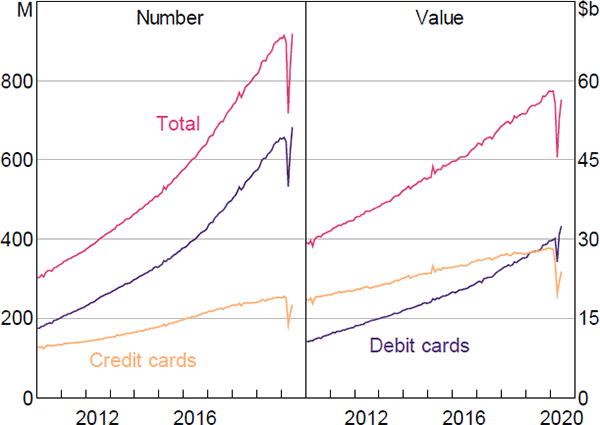
Notes: Includes all transactions made using Australian-issued cards, excludes transactions made on foreign-issued cards; changes in reporting methodology in May 2018
Source: RBA
While consumers of all ages used debit cards more frequently than they did in the previous survey, the recent increase has been most pronounced among younger consumers. The share of payments made using debit cards by consumers aged under 40 increased by 23 percentage points between the 2016 and 2019 surveys (Figure 17). These respondents are increasingly using debit cards instead of cash and, to a lesser extent, credit cards for their everyday transactions.
As a result, consumers aged under 30 made just under 70 per cent of their payments using debit cards (Figure 18). While this partly reflects the fact that consumers in this age group are less likely than those in other age cohorts to hold a credit card, younger people that did own a credit card still made over half of their payments using a debit card.[21] In contrast, consumers aged 65 and over made around 20 per cent of their payments with a debit card, with relatively little difference in debit card use between those who held a credit card and those who did not.
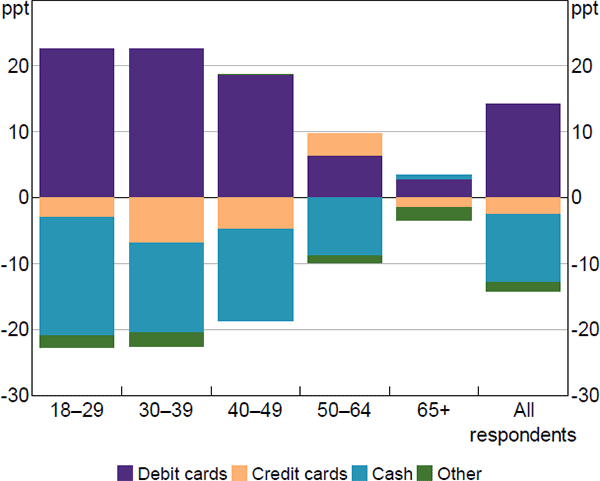
Source: RBA calculations, based on data from Ipsos and Roy Morgan Research
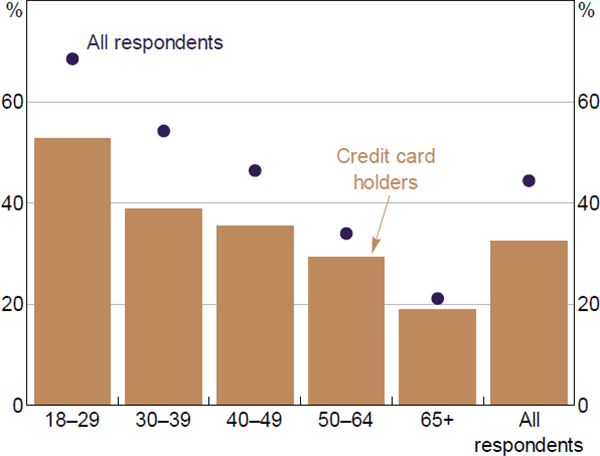
Source: RBA calculations, based on data from Roy Morgan Research
The share of payments made using cards increased across most broad merchant categories, and cards are now the most commonly used method of payment at many businesses (Table 4). As noted above, there has been a significant shift to contactless card payments from cash at smaller (non-supermarket) food retailers, such as cafés, pubs and takeaway food outlets. Between 2016 and 2019, the share of card payments at these businesses increased by 19 percentage points (to 62 per cent) as acceptance of cards for low-value payments has become common. The use of cards also continued to increase at supermarkets, with cards accounting for nearly three quarters of supermarket payments. Supermarkets were among the first businesses to introduce contactless card terminals in Australia in the early 2010s, so the recent increase in card use is likely to mostly reflect consumer preferences as well as greater use of self-service checkouts.
| 2007 | 2010 | 2013 | 2016 | 2019 | ||||||||||
|---|---|---|---|---|---|---|---|---|---|---|---|---|---|---|
| Cash | Card | Cash | Card | Cash | Card | Cash | Card | Cash | Card | |||||
| Payment value ($) | ||||||||||||||
| 1–10 | 95 | 4 | 91 | 7 | 78 | 18 | 62 | 32 | 45 | 52 | ||||
| 11–20 | 77 | 21 | 71 | 26 | 56 | 39 | 42 | 52 | 31 | 64 | ||||
| 21–50 | 55 | 40 | 50 | 43 | 37 | 54 | 28 | 61 | 22 | 70 | ||||
| 51–100 | 36 | 54 | 29 | 59 | 23 | 63 | 18 | 65 | 13 | 74 | ||||
| 101–500 | 30 | 51 | 20 | 53 | 14 | 59 | 14 | 62 | 10 | 64 | ||||
| 501+ | 19 | 49 | 14 | 41 | 7 | 51 | 11 | 50 | 3 | 52 | ||||
| Broad merchant categories | ||||||||||||||
| Supermarket | 60 | 39 | 54 | 46 | 38 | 59 | 31 | 63 | 24 | 74 | ||||
| Food retail | 90 | 10 | 85 | 14 | 72 | 27 | 55 | 43 | 36 | 62 | ||||
| Goods retail | 62 | 35 | 56 | 40 | 40 | 48 | 30 | 55 | 23 | 67 | ||||
| Transport(b) | 82 | 15 | 73 | 17 | 58 | 34 | 37 | 49 | 20 | 71 | ||||
| Petrol/service station | 45 | 51 | 43 | 54 | 31 | 66 | 29 | 67 | 23 | 76 | ||||
| Leisure/entertainment | 85 | 12 | 75 | 19 | 49 | 36 | 46 | 37 | 33 | 50 | ||||
| Holiday | 25 | 65 | 21 | 69 | 4 | 74 | 2 | 79 | 4 | 81 | ||||
| Bills(c) | 37 | 28 | 16 | 22 | 12 | 33 | 12 | 35 | 7 | 29 | ||||
| Services | 51 | 27 | 56 | 33 | 50 | 38 | 35 | 46 | 26 | 48 | ||||
| Other | 63 | 25 | 55 | 30 | 40 | 41 | 38 | 47 | 27 | 56 | ||||
|
Notes: (a) Excludes payments over $9,999, transfers (payments to family and friends) and automatic payments; cash and card percentages do not sum to 100 due to the use of other payment methods Source: RBA calculations, based on data from Colmar Brunton, Ipsos and Roy Morgan Research |
||||||||||||||
Overall, consumers appear to increasingly value convenience when making their day-to-day payments. When asked what influences their choice of payment method, 23 per cent of respondents said that ‘whatever I have with me’ was the most important factor for in-person payments, compared to 14 per cent in 2016 (Figure 19). For an increasing share of consumers, it appears that cards are more convenient than cash (which needs to be physically withdrawn from bank accounts – for example, by visiting an ATM – or cash holdings). Consumers were also more likely to nominate factors associated with debit rather than credit products. Between 2016 and 2019 more consumers nominated a preference for using own funds as their most important factor, while fewer nominated rewards points.
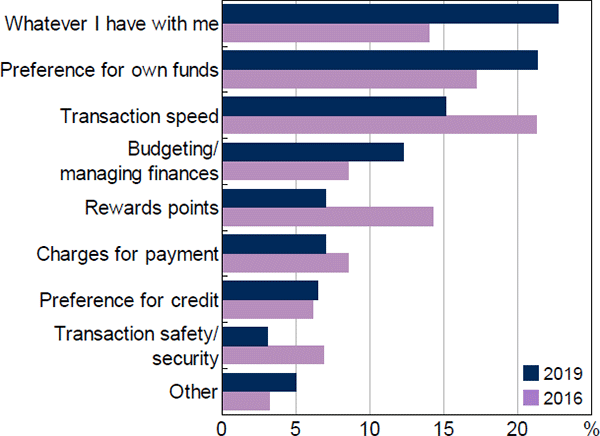
Source: RBA calculations, based on data from Ipsos and Roy Morgan Research
5.2 Contactless Card Payments and Mobile Wallets
The way in which consumers use their cards has changed significantly over the past decade or so. Most in-person card payments are now made using contactless functionality rather than by inserting the card into the terminal (and then entering a PIN), and consumers are increasingly storing their card details in mobile wallets.[22]
Contactless transactions – initiated by tapping either a physical card or mobile device – accounted for all of the growth of card payments at the point of sale relative to the previous survey. Around 50 per cent of in-person payments were made using a physical (plastic) card with contactless functionality in 2019, and a further 5 per cent using payment-enabled mobile devices (compared to a combined total of 35 per cent three years earlier) (Figue 20, left panel). The share of payments made using contactless functionality is likely to have further increased since the CPS was conducted in late 2019 because of changes in behaviour associated with COVID-19 by both consumers and merchants. Payment providers have facilitated a move to contactless transactions by (temporarily) increasing the transaction limit below which a PIN is not required for a contactless card payment from $100 to $200.
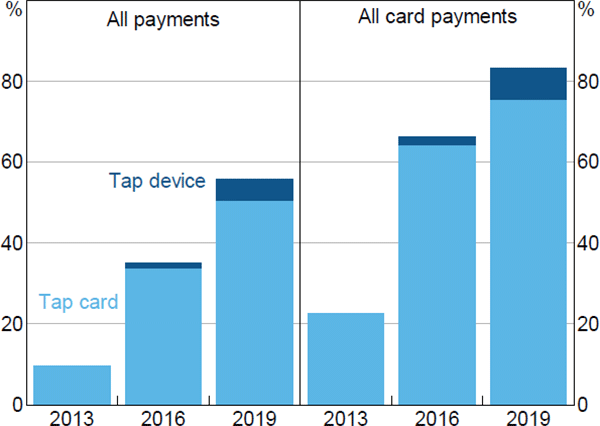
Source: RBA calculations, based on data from Colmar Brunton, Ipsos and Roy Morgan Research
As noted, one of the implications of the widespread adoption of contactless functionality by consumers and merchants is that it has facilitated the use of cards for relatively low-value transactions. For example, the share of in-person payments of $10 or less made by tapping a card or device increased by a further 23 percentage points between 2016 and 2019, to 48 per cent (Figure 21). For payments of this size, consumers generally substituted from cash to contactless cards. Contactless payments are, however, generally displacing cash and ‘insert card’ options across a range of transaction sizes.
While most contactless payments were initiated by tapping a physical (plastic) credit or debit card on the card terminal at checkout, the use of mobile devices to make contactless payments has increased sharply from a low base. These payments are made by tapping or waving a smartphone or other payment-enabled mobile device (e.g. watch, ring or other ‘wearable’) in front of a card terminal, rather than using a physical card. Contactless device payments accounted for 8 per cent of in-person card payments in 2019, which was a notable increase from 1 per cent in 2016 (Figure 20, right panel). The increased adoption of contactless mobile payments is consistent with the wider availability of this payment option for consumers (e.g. via their financial institution's mobile banking app or a third-party provider), consumers' greater awareness of this payment method and widespread merchant acceptance of cards more generally. At the time of the 2016 survey, the ability to make mobile payments was still a relatively new feature of the retail payments system, whereas it is now a more common product offering across card issuers.[23] The availability of a range of devices equipped with mobile payment functionality has also increased in recent years.[24] Consistent with broader trends, it has become increasingly common for debit cards to be used for contactless mobile payments, with two-thirds of these payments using a debit card in 2019, compared with one-quarter in 2016.
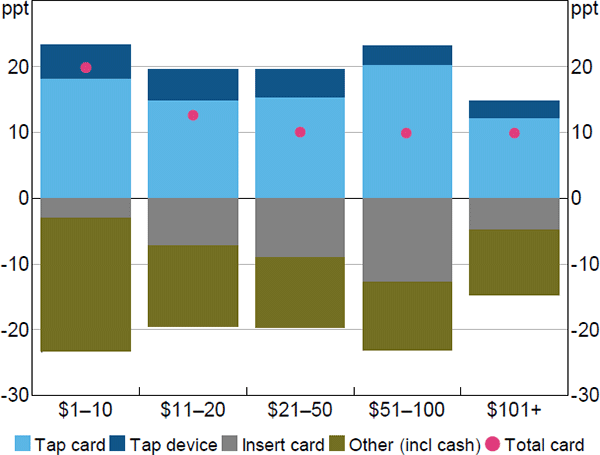
Source: RBA calculations, based on data from Ipsos and Roy Morgan Research
The growth in mobile payments was driven by increased use among consumers aged under 40. Whereas around 10 per cent of all respondents in 2019 made at least one contactless mobile payment during the diary week, nearly 20 per cent of people under 40 recorded at least one such payment (Figure 22). These younger consumers who had adopted mobile payments made just over one-half of their in-person payments using this method, with users in most other age groups also making a significant share of their in-person payments this way (Figure 22).
The strong growth in mobile payments seen in the latest survey is likely to continue. When asked if they had card details stored in a mobile wallet, around 20 per cent of respondents said they did, with around 40 per cent of those aged under 40 reporting that they held card details in this way (Figure 23). While most mobile wallet users stored only one card in their wallets, a sizeable minority had stored more than one card. Moreover, nearly 90 per cent of CPS respondents indicated that they were aware of the ability to make tap-and-go payments via a payments-enabled mobile device (see Section 8.1). Some banks have recently been promoting the use of mobile payments in response to COVID-19.
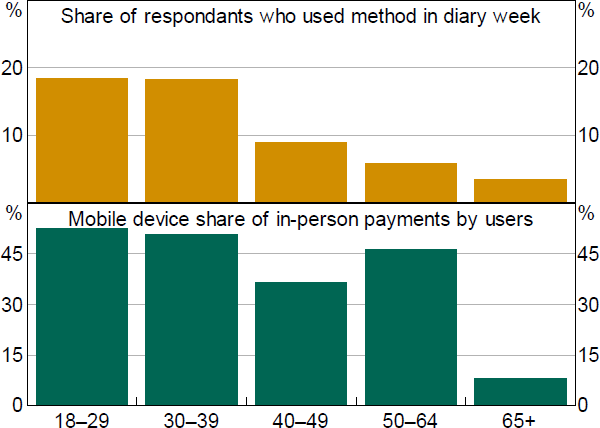
Source: RBA calculations, based on data from Roy Morgan Research
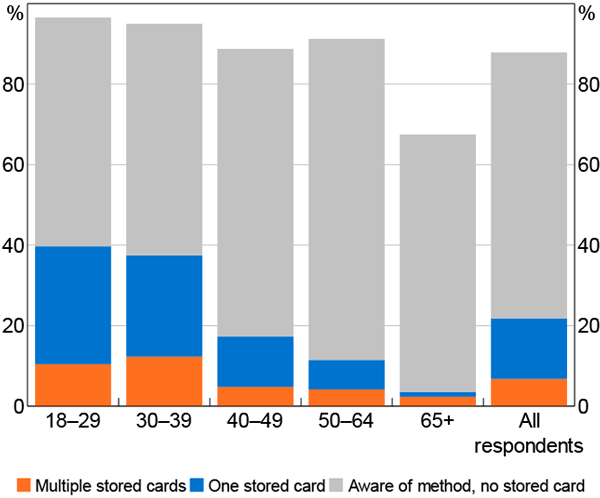
Source: RBA calculations, based on data from Roy Morgan Research
5.3 Surcharging of Card Transactions
The Reserve Bank's rules on surcharging allow businesses to recover the cost of accepting different card payments but prevent them from surcharging excessively.[25] To recover their costs, a merchant may apply an additional fee, or surcharge, for accepting particular card payments. Changes to the surcharging rules took effect for large merchants from September 2016 (and for small merchants in September 2017), which resulted in reductions in surcharges levied by merchants in some industries where concerns had been raised about excessive surcharges on some lower-value transactions. Most notably, the domestic airline industry moved from fixed-fee surcharges to a percentage-based surcharge with a fee cap, which had the effect of reducing the dollar value of surcharges on relatively cheap domestic flights.
The survey provided mixed evidence on developments in the frequency and size of surcharges which may reflect the small number of surcharges recorded and potential reporting issues.[26] CPS participants reported that a surcharge was paid on 4 per cent of card transactions on average in 2019 (Table 5). When measured as a percentage of the transaction value, the median surcharge was 1.5 per cent, which was 50 basis points higher than three years earlier, although in value terms, the median surcharge declined from 80¢ to 60¢. The reduction in the median surcharge amount is consistent with increased use of cards for lower-value purchases between 2016 and 2019.
A number of factors were associated with whether a surcharge was paid by consumers. These included the type of card used, the environment in which the payment was made (e.g. online or in-person) and the propensity to switch to a non-surcharged payment method (or merchant) when faced with a surcharge. The CPS indicated that surcharges were more often paid on credit card payments (5 per cent of transactions) than on debit cards (3 per cent), which is consistent with credit cards tending to be more expensive for merchants to accept than debit cards and therefore more likely to be surcharged (Occhiutto 2020). Consumers who held a credit card that offered rewards points – which tend to be relatively expensive for merchants to accept – were also more likely to have paid a card surcharge than those who owned a non-rewards credit card.
Consistent with previous survey waves, it was more common for respondents to have paid a surcharge for online card payments (8 per cent) than in-person payments (3 per cent). This difference could partly be because consumers are more likely to have a ready alternative to cards for in-person payments, that is, cash. Online transactions are also sometimes more expensive for merchants to accept.
| Per cent of card payments where a surcharge was paid | |
|---|---|
| All card payments | 3.9 |
| Credit cards | 5.0 |
| Debit cards | 3.4 |
| Reward cardholder status | |
| Owns a rewards card | 5.7 |
| Does not own a rewards card | 2.9 |
| By payment channel | |
| In-person | 3.2 |
| Online | 8.4 |
|
Note: Excludes payments over $9,999, transfers (payments to family and friends) and automatic payments Source: RBA calculations, based on data from Roy Morgan Research |
|
The 2019 CPS also asked respondents about their typical response when they know that a merchant levies a surcharge on some payment methods. Around 50 per cent of respondents indicated that faced with a surcharge they would instead choose a non-surcharged method to make the payment. This indicates that there is typically scope for merchants to encourage consumers to switch to a different, lower-cost payment method by applying a surcharge on certain payments. A further 21 per cent of respondents said they would pay a surcharge to use their preferred payment method and around 25 per cent would avoid shopping at that merchant (Figure 24). The possibility of losing business is likely to help explain why many merchants choose not to apply a surcharge on card payments.
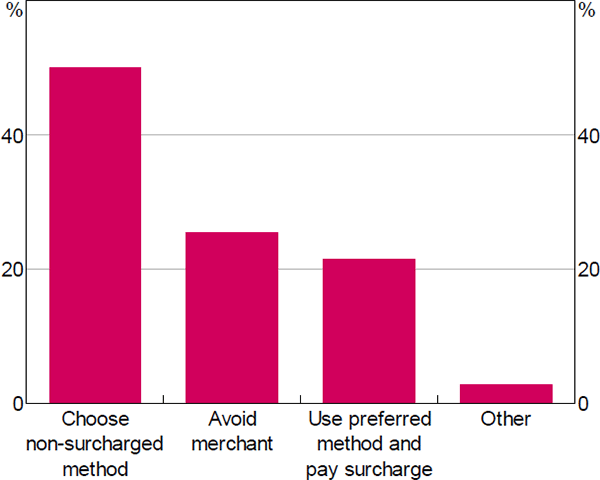
Source: RBA calculations, based on data from Roy Morgan Research
6. Online and Automated Payments
6.1 Online
The 2019 CPS showed that the share of consumer payments made online – rather than in-person at the point of sale – was little changed from previous years, at 13 per cent of the number of payments (Table 6). By value, online payments accounted for 35 per cent of all consumer payments in 2019. Consumers are, however, increasingly making these online payments via mobile devices and apps: in 2019, 40 per cent of online payments were initiated via mobile apps.[27] App-based payments were relatively common for household bills and for transport-related payments, with the latter consistent with the growth in popularity of ride-sharing apps. Since the CPS was conducted late last year, there has been increased use of online shopping as consumers changed their purchasing behaviour and merchants increased their online capabilities in response to the COVID-19 situation. This may have led to a more permanent shift in purchasing patterns for some consumers and it would not be surprising if the online share of consumer payments is higher in future surveys.
It is also worth noting that the figures for online payments shown in the top panel of Table 6 do not include participants' automatic payment arrangements (e.g. direct debits), which are recorded separately in a post-diary questionnaire (see Section 6.2). When combined, the share of total weekly spending accounted for by automated and online payments has increased by 6 percentage points since 2013 (Table 6, bottom panel).
| 2007 | 2010 | 2013 | 2016 | 2019 | |
|---|---|---|---|---|---|
| Online payments as a share of consumer payments(a) | |||||
| Number | 3 | 7 | 13 | 13 | 13 |
| Value | 13 | 26 | 36 | 39 | 35 |
| Mobile/app as a share of online payments(b) | na | na | 6 | 20 | 40 |
| Online and automatic payments as a share of total spending(c) | |||||
| Number | na | na | 17 | 20 | 23 |
| Value | na | na | 43 | 48 | 49 |
|
Notes: (a) Excludes payments over $9,999, transfers (payments to family and friends), transport cards and automatic payments Source: RBA calculations, based on data from Colmar Brunton, Ipsos and Roy Morgan Research |
|||||
Card payments accounted for 48 per cent of the number of online payments (and 39 per cent by value). Within the figures for cards, the share of online payments made using a debit card increased by 9 percentage points between 2016 and 2019 (to 29 per cent) while the credit card share declined over this period. PayPal was used for a further 14 per cent of online transactions, while BPAY and bank transfers accounted for much of the remaining online payments.[28] Buy now, pay later (BNPL) services were identified as a distinct ‘payment method’ for the first time in the latest CPS (BNPL is discussed further in Section 8). Despite strong growth in transaction volumes in recent years, BNPL accounted for just 3 per cent of the total number of online payments in the 2019 survey (and 1 per cent by value). The share was higher for certain merchants, with BNPL accounting for 10 per cent of the number of online goods purchases, for example.
The share of respondents that made at least one online payment in 2019 was 55 per cent, which was about the same as in the 2013 and 2016 surveys but double the share of people surveyed in 2007. Online payments continue to be made most frequently by younger respondents, with two-thirds of people aged under 40 having made at least one online payment during the 2019 diary week (Figure 25, top panel). The online payment users in this age group made nearly one-quarter of their weekly purchases online on average, more than half of the time via mobile apps (Figure 25, bottom panel). When respondents in older age groups made online purchases, they tended to use apps less frequently.
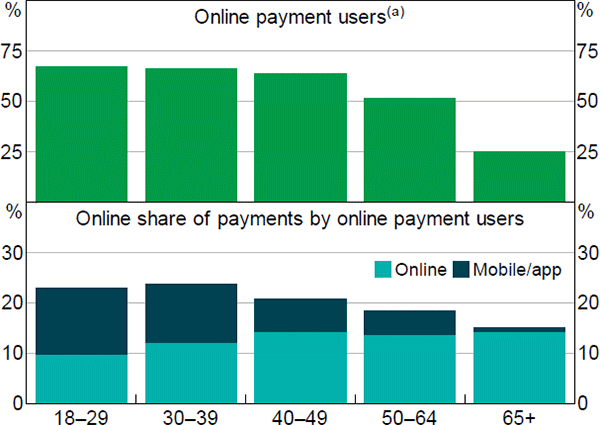
Note: (a) Share of respondents who made at least one online payment in the diary week
Source: RBA calculations, based on data from Roy Morgan Research
As noted above, many CPS respondents also reported that they had used debit or credit card details that had previously been stored on a computer, device or within an app to make an online payment (as opposed to filling in their card details at the checkout stage of the transaction). This includes, among other things, choosing to autofill stored payment credentials when shopping online, and payments made via apps in which the payment is embedded and occurs in the background at the time of a transaction (e.g. transport ride-sharing apps). Around 45 per cent of survey participants had used stored payment details for an online payment in the previous year (Figure 26). This is consistent with a trend towards payments becoming more seamless from the perspective of consumers. Most consumers using stored card details reported that they had only one card stored online, while 29 per cent had multiple stored cards. The propensity to store only one card could be an indication that consumers may be inclined to ‘set and forget’ their payment method as transactions become more seamless. To the extent that this results in consumers being less responsive to the relative costs of different payment methods, there could be implications for competition and efficiency in the retail payments market.
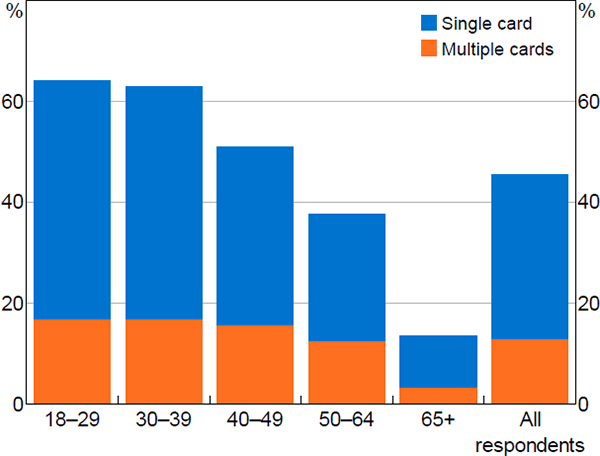
Note: Respondents who made at least one payment using stored card details in the previous 12 months
Source: RBA calculations, based on data from Roy Morgan Research
6.2 Automatic Payments
In addition to recording payments that they initiated during the diary week, respondents were asked details about automatic payments that occurred during the week as part of a post-diary questionnaire. These automatic payments include pre-authorised direct debit payments for bills (e.g. rent, phone and utility bills or digital service subscriptions), regular debt repayments (mortgage or credit card repayments) and recurring ‘pay anyone’ transactions set up via internet banking.
Automatic payment arrangements are becoming more common, with 81 per cent of respondents in 2019 reporting that they had at least one automatic payment arrangement, compared with 65 per cent in 2016. Automatic payments in the diary week accounted for 21 per cent of the value of respondents' weekly expenditure in 2019, compared to 16 per cent in 2016 and 11 per cent in 2013 (Figure 27). Alongside increased use, the median value of automatic payments fell to $60 in 2019 from around $75 in 2013.[29] Around 50 per cent of household bills are now paid automatically, compared to 40 per cent in 2016.
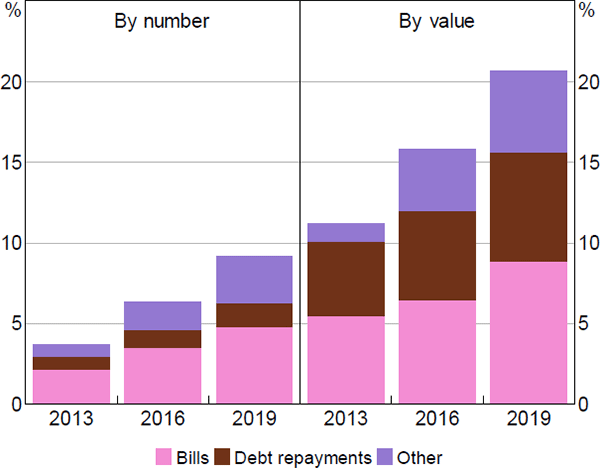
Source: RBA calculations, based on data from Colmar Brunton, Ipsos and Roy Morgan Research
7. Cheques
The 2019 CPS provided further evidence of the long-term decline in the cheque system, with personal cheques accounting for only 0.2 per cent of the number of payments made during the week of the survey. While this was a similar share to that recorded in 2016, it was down from 1.2 per cent in 2007 and confirmed that personal cheques are seldom used to make consumer payments. In the few cases where they are used, personal cheques tend to be used for relatively large consumer expenditures such as household bills and services. Accordingly, cheque payments had a higher median value ($111) than cash ($12) or card ($26) payments.
As in previous surveys, the use of cheques was heavily concentrated among older Australians. Indeed, all of the personal cheque payments recorded in the 2019 CPS were by respondents aged over 50, with 80 per cent of them made by people aged over 65. Nevertheless, for consumers aged over 65, personal cheques represented less than 1 per cent of their number of weekly payments, down from about 2 per cent in 2007, often for household bills (Figure 28). Despite not recording any cheque payments in the week of the diary, around 5 per cent of respondents aged under 50 had made at least one cheque payment in the previous year (Figure 29). Overall, 13 per cent of respondents reported having made a cheque payment at some point in the previous year. Consumers who reported using cheques typically said they did so infrequently, although 10 per cent of respondents aged over 65 indicated that they used cheques every few weeks or more often.
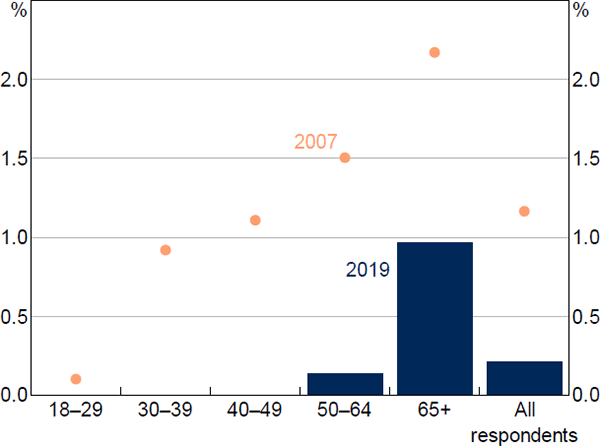
Note: No personal cheque payments were recorded by respondents aged under 50 in 2019
Source: RBA calculations, based on data from Roy Morgan Research
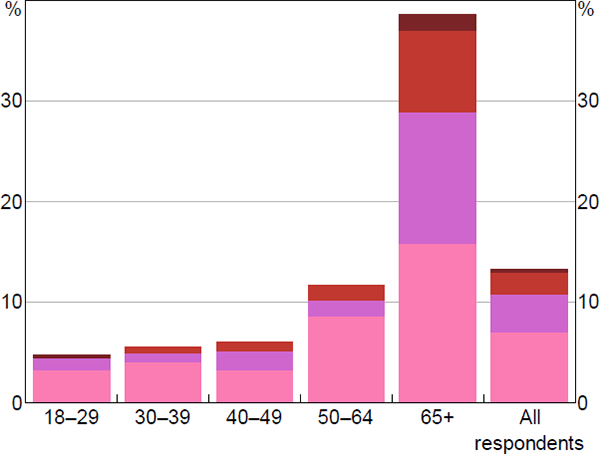
Source: RBA calculations, based on data from Roy Morgan Research
Because cheques are not used very often by most consumers, it will likely be appropriate at some point that the industry winds up the cheque system given the high per-transaction cost of cheque payments (e.g. Bullock 2020). However, it will be important that alternative payment methods are available and accessible for those who currently are continuing to use cheques. In this regard, the CPS indicated that the majority of cheque users do so out of a preference for cheques for some payments, although some respondents attributed their use of cheques to not having access to an alternative means of payment or that the receiver only took cheques (Figure 30).
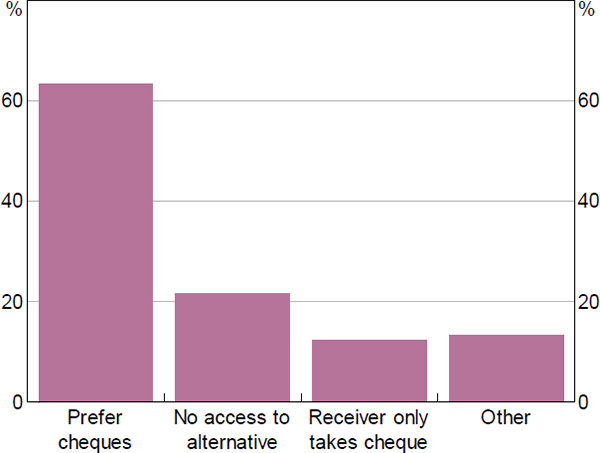
Notes: Share of users who made a personal cheque payment in the last 12 months; respondents could choose more than one response
Source: RBA calculations, based on data from Roy Morgan Research
8. Innovation in Payments
8.1 Alternative Payment Methods
Australian consumers have access to a wider range of electronic alternatives to cash and traditional (plastic) cards than they did even a few years ago. A number of innovative new products and services have emerged or attracted increased attention, often facilitated by mobile technology. Many of these new payment services make use of existing card networks – for example, by using stored card details ‘in the background’ – but enable consumers to use cards in new ways. An example of this is the use of linked debit or credit cards to fund instalment payments for purchases made with BNPL services. Other innovations have involved the creation of new networks to facilitate payments, most notably the introduction of the New Payments Platform (NPP) which has provided consumers with the ability to make real-time, data-rich account-to-account bank transfers using PayIDs.[30]
To gauge awareness and use of some of these newer means of payment, the CPS asked respondents whether they had heard of a number of alternative payment options and, if so, whether they had used them at least once in the previous 12 months.
In terms of awareness, most respondents had heard of several of the newer payment technologies, with awareness highest for BNPL services, at 90 per cent, and cryptocurrency (82 per cent) (Figure 31). Cryptocurrencies (e.g. Bitcoin) are designed as an alternative means of payment to sovereign currencies and may also be held for investment or speculative purposes.[31] Although many respondents had heard of cryptocurrencies, very few (less than 1 per cent) had used a cryptocurrency such as Bitcoin to actually make a consumer payment over the previous year.[32] Awareness was also relatively high for mobile-enabled payments such as mobile device ‘tap and go’ payments (88 per cent; see Section 5.2) and in-app payments on a mobile phone (70 per cent; see Section 6.1).

Note: ‘Used method’ is the share of respondents who reported using a method in the past 12 months
Source: RBA calculations, based on data from Roy Morgan Research
A number of other non-traditional means of payment were neither widely recognised by consumers nor commonly used to make payments. For example, AliPay and WeChat Pay – which are very popular digital wallet services in China – had only been used by 1.5 per cent of CPS participants in in the previous 12 months.[33] Most respondents had not heard of Beem It, an app owned by several large Australian financial institutions that facilitates person-to-person transactions. While relatively few people indicated that they had heard of or used PayID as a way of addressing NPP payments (33 and 11 per cent, respectively), this is likely to underestimate the use of the NPP service overall because people may not be aware that many of their bank transfers may be processed through this system (discussed further below).
A notable development in the Australian retail payments system over the past few years has been the emergence of BNPL services. These services enable consumers to obtain goods and services immediately and make subsequent payments in a series of interest-free instalments, typically drawn from a linked debit or credit card.[34] As noted, most respondents had heard of BNPL services, and just under 20 per cent reported that they had made at least one BNPL payment over the previous year (Figure 32). According to the CPS, consumers aged between 30 and 39 were most likely to have used BNPL at least once over the previous year (32 per cent), with over 20 per cent of respondents aged between 18–29 and between 40–49 also reporting that they had used BNPL in the previous year (Figure 32).
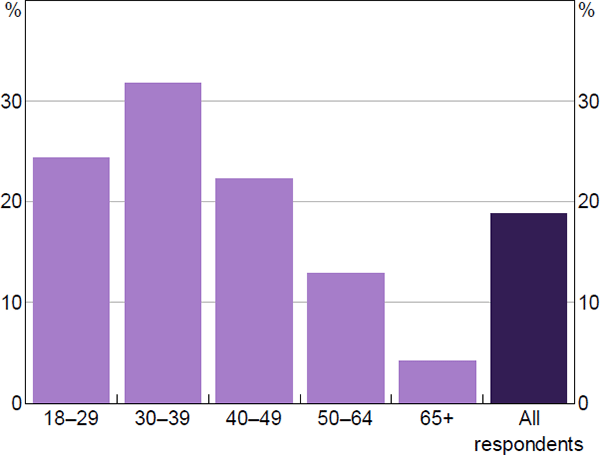
Source: RBA calculations, based on data from Roy Morgan Research
Overall, people who had used BNPL reported that they typically made payments using these services infrequently; 70 per cent of users paid with BNPL every few months or less often, while only 3 per cent used BNPL at least once a week (Figure 33). Younger people tended to use BNPL more frequently than those in older age groups, with 35 per cent of BNPL users aged under 30 using these services at least once a week or every few weeks. The relatively low frequency with which BNPL services are used by most consumers is likely to partly reflect the nature of the purchases made with these services. For example, to date BNPL has been mostly available for ‘discretionary’ retail purchases, whereas it is not typically accepted at businesses such as supermarkets or other food retailers.
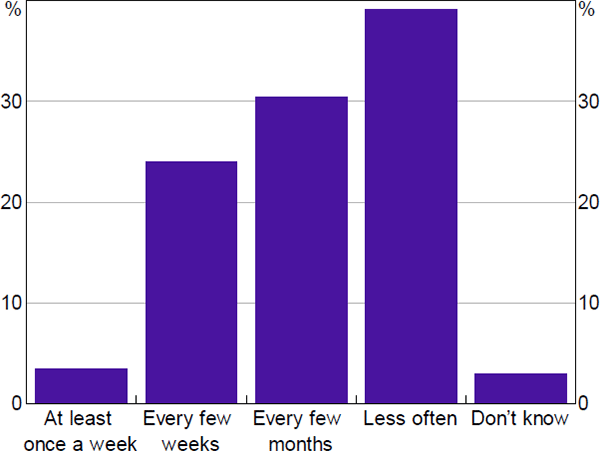
Source: RBA calculations, based on data from Roy Morgan Research
If participants in the CPS had heard of but not used an alternative payment method, they were asked about their reasons for not using it. Of these respondents, the majority reported that one of the main reasons was because they felt that their existing payment methods met their needs. For example, 78 per cent of people who were aware of BNPL said their existing methods met their needs, with concerns about spending control (23 per cent) and a lack of knowledge or tools to use the method the next most commonly cited reasons for not using BNPL (Figure 34). Those who hadn't used cryptocurrency or contactless mobile device payments were relatively more likely to cite a lack of knowledge or tools as well as privacy and/or security concerns as reasons for not using those methods.
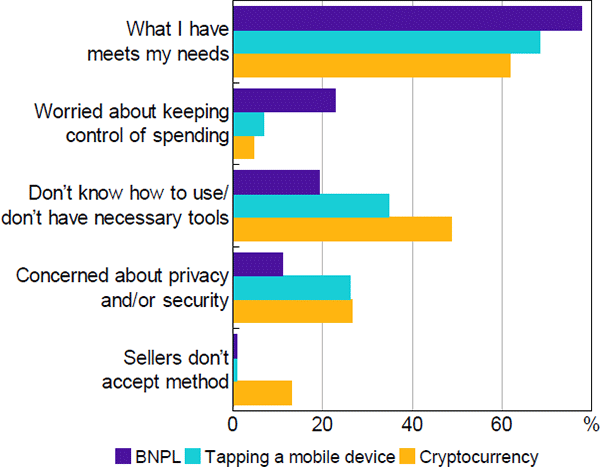
Note: Bars do not sum to 100 per cent as respondents could choose more than one answer and response of ‘Other reason’ not shown
Source: RBA calculations, based on data from Roy Morgan Research
8.2 Person-to-person Payments
The way in which people can make person-to-person payments to family and friends (transfers) has changed significantly because of the introduction of new technologies. Since its launch in February 2018, the NPP has allowed customers of more than 90 financial institutions to make fast data-rich payments 24 hours a day; over 66 million Australian bank accounts are able to make and receive payments through the NPP (Fitzgerald and Rush 2020). Separately, mobile apps have been developed to facilitate quick and easy transfers to friends and family (e.g. Beem It) and even provide pocket money.
These new payment technologies have facilitated a shift to transferring money electronically using mobile apps rather than providing cash. While the overall number of peer-to-peer transfers has remained steady as a share of consumer payments since 2013 (2 per cent of the number of consumer payments), mobile and app-based transfers accounted for 40 per cent of transfers, compared to 10 per cent in 2013 (Figure 35).[35] The increase in the use of mobile technology for transfers has been led by younger age groups, with respondents aged under 30 making two-thirds of their transfers using apps.

Source: RBA calculations, based on data from Colmar Brunton, Ipsos and Roy Morgan Research
8.3 Transport Cards
In addition to increased information on alternative payment methods, the 2019 CPS collected information on the use of pre-paid transport cards such as Myki and Opal for the first time.[36] These types of cards have been rolled out across many public transport systems in Australia, though more recently some public transport terminals have enabled fares to be paid directly by tapping a debit or credit card on the terminal rather than a specific transport card. In the interest of ensuring comparability with previous survey waves, the analysis in the preceding sections does not include payments made with transport cards. In 2019, these payments were equivalent to 2 per cent of the number and 0.1 per cent of the value of consumer payments. The vast majority of transport-related payments are now made electronically, with cash accounting for less than 10 per cent of transport payments under $10 during the week of the diary.
9. Conclusion
The Bank's 2019 Consumer Payments Survey provided further evidence that Australian consumers are increasingly using electronic payment methods instead of cash for many of their transactions. The use of debit cards has been growing strongly in recent surveys, particularly for lower-value ‘tap and go’ payments. The share of payments made using mobile devices with contactless payment functionality has also risen sharply relative to previous surveys as awareness and card-issuer support for mobile payments has increased. While use of mobile devices for payments at the point of sale is still relatively low, mobile devices are now a relatively common way of making online and person-to-person payments through apps. Consumers also have available an increasing range of newer payment methods and the CPS showed that many consumers were aware of these, even if some of them were not necessarily widely used.
The changes in spending patterns induced by the emergence of COVID-19 in Australia – including a further shift away from cash and increased online shopping – are likely to reinforce the trend to electronic payments. As this transition occurs, it will be important to make sure that electronic payment systems are low cost, accessible and safe. As the transactional use of cash declines, it will also be important to consider the needs of those members of society who continue to rely heavily on cash for their day-to-day payments.
Appendix A: Survey Methodology
The fieldwork for the 2019 CPS was conducted by the research firm Roy Morgan Research on behalf of the Reserve Bank in October and November 2019. The survey consisted of three parts: a pre-diary questionnaire about the demographic characteristics of respondents; a seven-day payments diary; and a post-survey questionnaire about respondents' automatic payment arrangements and their preferences and attitudes about different payment methods. To encourage participation and engagement with the survey, respondents received a gift card on completion of the three components.
The survey was delivered online for most respondents but to ensure the sample was broadly representative of the Australian population, participants without internet access were recruited by telephone to complete a paper-based survey. The overall response rate was good, resulting in a final sample of 1,115 respondents (Table A1). Respondents recorded a total of around 16,000 transactions in the survey, comprising day-to-day payments, transfers to family or friends, automatic payments and cash top-ups (Table A2).
| Number recruited | Number of completed responses | Response rate (%) | |
|---|---|---|---|
| Online respondents | 1,661 | 950 | 57 |
| Offline respondents | 249 | 165 | 66 |
| Total | 1,910 | 1,115 | 58 |
|
Source: RBA calculations, based on data from Roy Morgan Research |
|||
| Number | Value ($) | ||
|---|---|---|---|
| Day-to-day payments | 13,083 | 1,386,804 | |
| Transfers and cash deposits | 552 | 399,523 | |
| Automatic payments | 1,474 | 266,247 | |
| Cash top-ups | 822 | 182,402 | |
| Total | 15,931 | 2,234,976 | |
|
Source: RBA calculations, based on data from Roy Morgan Research |
|||
A.1 Survey Instruments
Pre-diary questionnaire
The demographic information collected in the pre-diary questionnaire was mostly the same as that collected in 2016. Demographic variables included age, sex, personal and household income, family composition, household size, location (capital city or regional area), employment status, occupation, and education level. In 2019, the survey also asked whether respondents experienced any disabilities. A full list of debit and credit cards held by the respondent was collected, with the respondent also identifying their primary debit and credit card. Respondents also provided information about how they usually paid off their credit card debt (i.e. whether they paid off their debt every month or whether they let part of the balance roll over from month to month).
Payments diary
In the payments diary, respondents recorded details about every transaction they made for a week, excluding automatic payments (which were recorded in the post-survey questionnaire). These details included the value, payment method, payment channel and type of merchant. The payment methods and channels that respondents chose from were modified from 2016 to better match the ways that people pay – for example, BNPL services were added as a payment method. For card transactions, online respondents selected the specific card they used (from the list of cards they provided in the pre-diary questionnaire); offline participants only recorded the type of card they used (e.g. debit card, Visa/Mastercard credit card). Respondents also recorded the dollar value or percentage amount of any payment surcharges that they paid. Along with their payments, respondents were asked to include details of cash top-ups, including the value of any ATM fee paid. The full list of fields used in the 2019 diary is set out in in Table A3.
Post-survey questionnaire
In the post-survey questionnaire, respondents were asked to record details of any automatic payments that occurred during the diary week, referring to their latest bank statements.
In 2019, qualitative questions in the post-survey questionnaire focused on consumers' preferences and attitudes towards different payment methods. Key topics included use of and reliance on cash, payment preferences in different environments, awareness and use of new payment methods (such as BNPL services) and perceptions around privacy in payments.
| Payments | |
|---|---|
Date Day-of-week Payment amount Payment surcharge paid (dollar/per cent amount) Payment method:
Payment channel: In person
Not in person
|
Payment purpose:
|
| Cash top-ups | |
Date Day-of-week Cash top-up amount ATM fee paid (dollar amount) Total value of banknotes in wallet after top-up |
Source of cash:
|
|
Note: (a) Online respondents selected the specific card they used (from the list of cards they provided in the pre-diary questionnaire); offline respondents selected from: debit card, MasterCard/Visa credit card, American Express/Diners Club, or another credit card |
|
A.2 Survey Sample and Weighting
The overall sampling process for the 2019 CPS was similar to that used for the 2016 survey. To ensure the survey sample was broadly representative of the Australian population, there were minimum recruitment targets covering key demographic variables: age, sex, household income, location (i.e. capital city or regional area), credit card ownership, and household internet access. Recruitment targets for most demographic variables were based on data from the Australian Bureau of Statistics (ABS); data on credit card ownership were obtained from HILDA Survey Release 17.0. Minimum targets were based on a sample size of 1,000 respondents.
Recruitment for the survey commenced on Friday, 4 October 2019 using Computer Assisted Telephone Interviewing. Most recruits were obtained by Thursday, 10 October 2019; subsequent recruitment ensured each minimum recruitment target was met. Roy Morgan Research used a combination of automated email/SMS reminders and ad hoc contacts to support completions of the survey.
Due to different response rates across the demographic categories for which recruitment targets were set, we constructed survey weights so that the final (weighted) dataset aligns with population benchmarks. Essentially, weighting ensures that the survey data can be used to make inferences about the Australian population. We used the iterative proportional fitting procedure, or raking, to calibrate the survey weights; the same procedure was used for the 2016 CPS. We implemented the raking algorithm using the ‘ipfweight’ program in Stata 16.0. Table A4 presents the unweighted sample distribution for selected demographic variables, alongside the population distribution and the mean weight for respondents in each group.
| Unweighted sample proportion (%) |
Population proportion (%) |
Mean weight | |
|---|---|---|---|
| Age(a) | |||
| 18–24 | 12 | 12 | 0.98 |
| 25–34 | 19 | 20 | 1.02 |
| 35–44 | 14 | 18 | 1.19 |
| 45–54 | 14 | 16 | 1.15 |
| 55–64 | 17 | 15 | 0.87 |
| 65+ | 23 | 20 | 0.87 |
| Gender(a) | |||
| Female | 53 | 51 | 0.96 |
| Male | 47 | 49 | 1.04 |
| Location(a) | |||
| Regional | 40 | 33 | 0.81 |
| Capital city | 60 | 67 | 1.13 |
| Household income quartile(a),(b) | |||
| 1st | 25 | 24 | 0.95 |
| 2nd | 21 | 25 | 1.18 |
| 3rd | 26 | 26 | 0.87 |
| 4th | 26 | 24 | 1.04 |
| Credit card ownership(c) | |||
| Yes | 61 | 56 | 0.92 |
| No | 39 | 44 | 1.12 |
|
Notes: (a) Population proportion is based on ABS data Source: RBA calculations, based on data from ABS, HILDA and Roy Morgan Research |
|||
References
Bagnall J, S Chong and K Smith (2011), Strategic Review of Innovation in the Payments System: Results of the Reserve Bank of Australia's 2010 Consumer Payments Use Study, Reserve Bank of Australia, Sydney.
Bullock M (2020), ‘Panic, Pandemic and Payment Preferences’, Keynote Address at the Morgan Stanley Disruption Evolved Webcast, Online, 3 June.
Caddy J, L Delaney, C Fisher and C Noone (2020), ‘Consumer Payment Behaviour in Australia’, RBA Bulletin, March, viewed 27 August 2020.
Dark C, D Emery, J Ma and C Noone (2019), ‘Cryptocurrency: Ten Years On’, RBA Bulletin, June, viewed 27 August 2020.
Dark C, C Fisher, K McBey and E Tellez (2018), ‘Payment Surcharges: Economics, Regulation and Enforcement’, RBA Bulletin, December, viewed 27 August 2020.
Davies C, M-A Doyle, C Fisher and S Nightingale (2016), ‘The Future of Cash’, RBA Bulletin, December, pp 43–52.
Delaney L, N McClure and R Finlay (2020), ‘Cash Use in Australia: Results from the 2019 Consumer Payments Survey’, RBA Bulletin, June, viewed 27 August 2020.
Delaney L, A O'Hara and R Finlay (2019), ‘Cash Withdrawal Symptoms’, RBA Bulletin, June, viewed 27 August 2020.
Doyle M-A (2018), ‘Consumer Credit Card Choice: Costs, Benefits and Behavioural Biases’, RBA Research Discussion Paper No 2018-11.
Doyle M-A, C Fisher, E Tellez and A Yadav (2017), ‘How Australians Pay: Evidence from the 2016 Consumer Payments Survey’, RBA Research Discussion Paper No 2017-04.
Emery D, T West and D Massey (2008), ‘Household Payment Patterns in Australia’, in Payments System Review Conference, Proceedings of a Conference, Reserve Bank of Australia, Sydney, pp 139–176.
Finlay R, A Staib and M Wakefield (2018), ‘Where's the Money‽ An Investigation into the Whereabouts and Uses of Australian Banknotes’, RBA Research Discussion Paper No 2018-12.
Fitzgerald E and A Rush (2020), ‘Two Years of Fast Payments in Australia’, RBA Bulletin, March, viewed 27 August 2020.
Meredith J, R Kenney and E Hatzvi (2014), ‘Cash Use in Australia’, RBA Bulletin, June, pp 43–54.
Occhiutto K (2020), ‘The Cost of Card Payments for Merchants’, RBA Bulletin, March, viewed 27 August 2020.
Ossolinksi C, T Lam and D Emery (2014), ‘The Changing Way We Pay: Trends in Consumer Payments’, RBA Research Discussion Paper No 2014-05.
Rush A and R Louw (2018), ‘The New Payments Platform and Fast Settlement Service’, RBA Bulletin, September, viewed 27 August 2020.
Copyright and Disclaimer Notice
HILDA Survey Disclaimer
This paper uses unit record data from the Household, Income and Labour Dynamics in Australia (HILDA) Survey. The unit record data from the HILDA Survey was obtained from the Australian Data Archive, which is hosted by The Australian National University. The HILDA Survey was initiated and is funded by the Australian Government Department of Social Services (DSS) and is managed by the Melbourne Institute of Applied Economic and Social Research (Melbourne Institute). The findings and views based on the data, however, are those of the authors and should not be attributed to the Australian Government, DSS, the Melbourne Institute, the Australian Data Archive or The Australian National University and none of those entities bear any responsibility for the analysis or interpretation of the unit record data from the HILDA Survey provided by the authors.
Acknowledgements
We thank Clare Noone, Cameron Dark and Ed Tellez for their valuable contributions to the planning, design and implementation of the survey. We would also like to thank Michele Bullock, James Holloway, Tony Richards, John Simon, Chris Thompson and Grant Turner for their helpful advice, comments and suggestions. The views expressed in this paper are those of the authors and do not necessarily reflect the views of the Reserve Bank of Australia. The authors are solely responsible for any errors.
Footnotes
Roy Morgan Research conducted the fieldwork for the survey. For a summary of the results of the 2019 CPS see Caddy et al (2020). [1]
See Doyle et al (2017), Ossolinksi, Lam and Emery (2014), Bagnall, Chong and Smith (2011) and Emery, West and Massey (2008) for analyses of earlier CPS waves. [2]
In the 2016 CPS, debit and credit cards combined were used more frequently than cash. [3]
See Bullock (2020) for more information. [4]
Differences in survey design and coverage mean that the results of these surveys are not fully comparable. See Bagnall et al (2011) for an earlier discussion of the results of harmonised payments survey data. [5]
Governments and central banks in some countries where the transition away from cash has been particularly pronounced, such as Sweden, have implemented or are considering a range of policy measures designed to ensure ongoing access to cash distribution services. [6]
See Box B of Delaney, McClure and Finlay (2020) for further discussion of merchant acceptance of cash and cards. [7]
Because of the overlap between age and income groups, the figures for income quartiles are adjusted for respondents' age. In this context, regional areas refers to people who live outside capital cities.[8]
See Table A1 in Delaney et al (2020) for results of a logit regression where the dependent variable is whether or not a transaction was made using cash, and the explanatory variables either relate to the individual making the transaction (e.g. their age), or the transaction itself (e.g. the value of the transaction). See also Davies et al (2016) and Meredith, Kenney and Hatzvi (2014) for previous discussions of the use of cash in Australia.[9]
These participants are referred to elsewhere in this paper a ‘high cash users’. Conversely, we refer to ‘low cash users’ as participants who used cash for less than 20 per cent of their in-person payments.[10]
It is likely that there is some under-reporting of cash holdings, since people who hold a large amount of cash may not be willing to disclose this in a survey. Finlay, Staib and Wakefield (2018) use several methods to investigate how banknotes are used in Australia, including using data from previous waves of the CPS. They estimate that more than half of Australian banknotes on issue are being stored by the public, either domestically or overseas.[11]
Cash top-ups from ‘other’ sources may be under-reported because people could be reluctant to report large cash receipts for privacy reasons.[12]
The RPS show that the value of ATM withdrawals has fallen at a slower pace than the number of withdrawals, indicating a rise in the average value of each withdrawal (Statistical table C4 ‘ATMS – Seasonally Adjusted Series’, available at <https://www.rba.gov.au/statistics/tables/xls/c04hist.xlsx>).[13]
The fall in ATM withdrawals was greater than the fall in card payments over this time; between February and April 2020 the number of credit card transactions fell by 28 per cent and the number of debit card transactions fell by 19 per cent.[14]
See the Australian Payments Network website for statistics on ATM terminals (https://www.auspaynet.com.au/resources/device-statistics#atm).[15]
A quarter of respondents stated that they did not make cash deposits. The lower share of participants reporting positive perceptions of access to cash deposit facilities could partly reflect the fact that there are fewer locations where cash deposits can be made – for example, many ATMs do not take cash deposits.[16]
See Delaney et al (2020) for further discussion of attitudes to cash.[17]
In response to COVID-19, the banking industry announced in April 2020 that banks would send debit cards to Australian account holders who did not have a linked debit card (e.g. passbook holders). In the 2019 CPS, 95 per cent of respondents reported that they had a debit card. [18]
Note that ‘card payments’ in this paper generally refer to transactions where respondents reported that they directly used a physical (plastic) debit or credit card or a card stored in a mobile wallet. Where payment cards are used indirectly, such as using a linked card via PayPal or a buy now, pay later service, the payment is captured in data for that payment method rather than as a card payment. For comparability with previous surveys, prepaid/gift cards are not included in the figures cited for debit and credit card payments; these cards were used for less than 1 per cent of the number of payments in the 2019 CPS. [19]
The question asked of credit card holders was: ‘Considering both the monetary and non-monetary features of your card (e.g. annual fee, rewards, the interest you pay, the interest-free period, fraud protection, widespread acceptance, convenience, insurance, concierge services) ... Overall, how do you see the benefits and costs of owning your [credit] card?’; Doyle (2018) explores the real (rather than perceived) financial impact of credit card ownership and use. [20]
Of respondents aged under 30, 32 per cent owned a credit card versus 63 per cent of respondents aged over 30. [21]
A mobile wallet is an application on mobile devices like smartphones that stores card details and allows in-person payments to be made by using the near field communication (NFC) functionality of the mobile device by tapping the device on or near a compatible terminal. Mobile wallets can sometimes also be used to make online payments. [22]
In the past few years, many card issuers have allowed their cards to be used in the mobile wallet applications provided by Apple, Samsung and Google, for example. [23]
Examples include watches, rings, clothing and coffee cups. [24]
These rules are enforced by the Australian Competition and Consumer Commission. See Dark et al (2018) for a discussion of surcharging regulations in Australia. [25]
See Section 4.4 in Doyle et al (2017) for a discussion of the 2016 CPS results on surcharging. [26]
The 2019 CPS, for the first time, separately identified mobile apps as a means of initiating a payment.[27]
Bank transfers were defined as logging into internet banking or a bank ‘app’ or using telephone banking and using a BSB and account number or PayID to make a pay-anyone transaction.[28]
The median value of payments recorded in the diary was $25.[29]
A PayID is a simple unique identifier which links to a customer's transaction account so that fast payments can be made to that account through the NPP; a PayID is often an email address, phone number or ABN. See Rush and Louw (2018) for an overview of the NPP and the Fast Settlement Service. [30]
See Dark et al (2019) for further discussion of cryptocurrencies. [31]
Only 3 per cent of respondents reported holding cryptocurrency. [32]
Anecdotally, these services tend to mostly be used by Chinese visitors to Australia and accepted by businesses that cater to tourists. [33]
Prominent BNPL services include AfterPay and ZipPay and there have been a number of new entrants into this market in recent years. [34]
The definition of an app-based payment has changed over survey years. In 2019, we asked whether consumers made a payment online, or through an app. In 2016 and 2013, we asked if a payment was made online by a smartphone/SMS payment. [35]
Previous survey waves captured ‘top-ups’ of transport cards, rather than when the card was used for an individual trip; this survey captures both ‘top-ups’ and individual transport card use. [36]